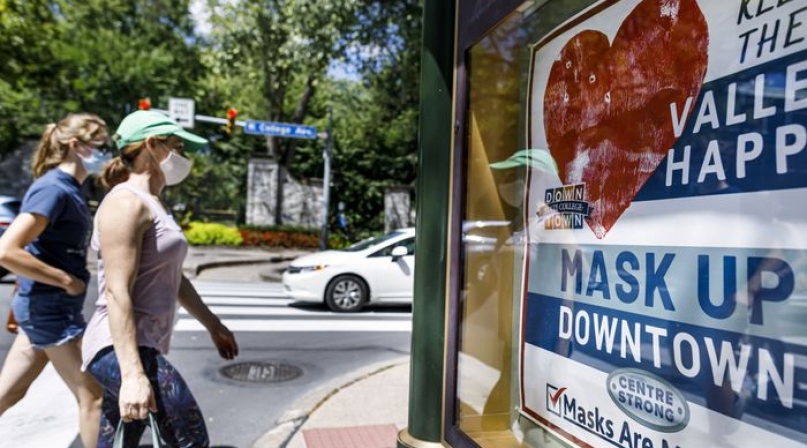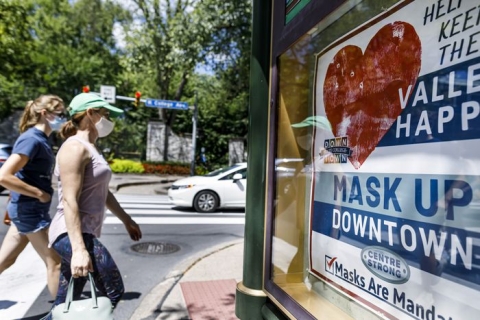COVID-19 cases spike in county college towns
Author
Upcoming Events
Related News

For counties with college towns, more students mean more pandemic problems.
In 203 counties where students make up at least 10 percent of the population, approximately 50 percent experienced their worst weeks of the pandemic since Aug. 1, according to a review by The New York Times.
Many counties are juggling COVID-19 cases among students while working to protect county residents outside of the student community.
At Michigan State University in Ingham County, the county health department issued a mandatory 14-day quarantine for fraternity and sorority houses and large rental properties.
The city of East Lansing, where the university is located, saw a 315 percent increase in total case counts since Sept. 1. An outbreak among students at the university drove the case count and comprises 80 percent of all new cases, according to a release from the county.
“I do not take this lightly, but there is an outbreak centered on Michigan State University and it is quickly becoming a crisis,” said Ingham County Health Officer Linda Vail in a statement.
Cases within the student community at the University of Arizona in Pima County also continued to increase throughout early September leading to similar self-quarantine recommendations for students.
Pima County Health Department Director Theresa Cullen worked with University of Arizona officials to issue the shelter-in-place self-quarantine recommendations for students within certain geographic areas near campus.
“We felt fairly strongly, especially when we looked at our census track data and the longitudinal tracking, that we were having significant escalation,” Cullen said.
Pima County’s public health department works closely with the University of Arizona through an academic public health partnership. Cullen is part of a public health advisory task force that advises the university in terms of pandemic response. Her office collaborated with the president of the University of Arizona, the county mayor and county administrator.
“Our concern — and it’s still a concern — is we can use the term ‘leakage’ to describe leakage of the pandemic into the surrounding neighborhoods,” Cullen said.
The New York Times previously labeled Centre County, Pa., home of Penn State University, the second fastest-growing county in the country with COVID-19 cases. Nearly 100,000 students attend the university in Centre County each year.
Centre County Commission Chair Mike Pipe said the county is working with the university, the state department of health and other stakeholders to launch the COVID-19 Response for Emergency Assistance to Counties Team (C-REACT), a task force to reduce positive cases on campus and in the surrounding community.
“That C-REACT team is basically going to be coming in and working specifically on actionable things that can occur — crunching data, looking at tests and it’s going to be a focus group and reduce approval times,” he said.
Pipe said the county has also been involved in an initiative created by the chamber of commerce and the university called Centre Strong, which created procedures for students moving back to campus and helps relay information regarding university cancellations.
“I think our challenge right now is to stop the spike and get to the plateau. Then if we are plateauing or just even decreasing, just really hammer that home and make sure we are not seeing continued spread,” Pipe said.
In Albany County, N.Y., officials traced the vast majority of new cases back to the University at Albany, part of the State University of New York school system. Over a recent five-day span, the county reported 105 new positive cases with 75 of those associated with the university.
Albany County Executive Daniel McCoy said the county is in constant communication with the university. He has worked with the university’s president and chancellor to announce pooled COVID-19 testing to administer tests rapidly.
“One of the things we saw over the summer and more recently once the fall semester started at the University at Albany, is that large gatherings can easily become disastrous with just a few people carrying the virus,” McCoy said.
To protect the rest of the county community, McCoy said the department of health has identified and isolated positive cases among students to protect the rest of the county’s residents. If the University at Albany sees more than 100 positive cases within a 14-day period, in-person classes will be suspended per state guidelines.
In Illinois, McLean County Health Administrator Jessica McKnight said the county saw a 2 to 3 percent positivity rate throughout the summer, but when students returned to Illinois State University in early August, the rolling seven-day positivity rate increased to 11 to 12 percent.
The Illinois State Department of Health offers a mobile testing program available to counties upon request which McKnight said the county asked for to bring increased testing to the university’s campus. The county has also been working closely with the university in regard to contact tracing efforts.
“The need obviously is showing to be a little bit greater than we anticipated with the number of cases that came in at the beginning,” she said of the contact tracing efforts.
McLean County has worked with the university, the town of Normal and the City of Bloomington to institute ordinances related to bars and large gatherings of over 10 within a certain geographical area near the campus.
“My message for students is that they’re members of our community as well, and we look to them to be the future and help us,” McKnight said. “It’s going to take all of us working together to help our community move forward.”

Attachments
Related News

CMS issues new guidance on Medicaid Community Engagement Requirements
On December 8, the Centers for Medicare & Medicaid Services (CMS) released a Medicaid and CHIP Services Informational Bulletin (CIB) directing states on how to implement the Medicaid community engagement requirements enacted under Section 71119 of the One Big Beautiful Bill Act legislation (Public Law 119-21), or H.R. 1.

California county sales tax measure backfills federal healthcare cuts
Santa Clara County, Calif. will raise an estimated $330 million each year from a sales tax to backfill lose Medicaid funding.

